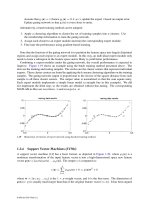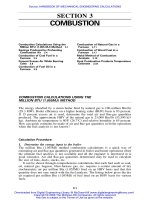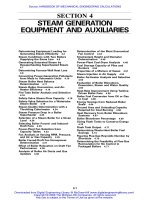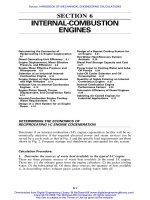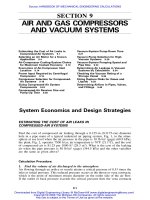Tài liệu Handbook of Organizational Behavior pdf
Bạn đang xem bản rút gọn của tài liệu. Xem và tải ngay bản đầy đủ của tài liệu tại đây (36.55 MB, 410 trang )
Public
Administration
and
Public
Policy/87
Handbook
of
Organizational
Behavior
Second
Edition,
Revised
and
Expanded
edited
by
Robert
T.
Golembiewski
Handbook
of
Organizational
Behavior
PUBLIC ADMINISTRATION
AND
PUBLIC POLICY
A
Comprehensive Publication Program
Executive
Editor
JACK
RABIN
Professor
of
Public Administration and Public Policy
School
of
Public Affairs
The Capital College
The Pennsylvania State University-Harrisburg
Middletown, Pennsylvania
1.
Public Administration as a Developing Discipline (in
two
parts), Robert
T.
Golem-
2.
Comparative National Policies on Health Care, Milton
I.
Roemer, M.D.
3.
Exclusionary Injustice: The Problem of //legally Obtained Evidence, Steven R. Schles-
4.
Personnel Management in Government: Politics and Process, Jay M. Shafritz, Walter
5.
Organization Development in Public Administration (in two parts), edited by Robert T.
6. Public Administration: A Comparative Perspective, Second Edition, Revised and Ex-
7.
Approaches to Planned Change (in two parts), Robert
T.
Golembiewski
8. Program Evaluation at HEW (in three parts), edited by James
G.
Abert
9.
The States and the Metropolis, Patricia
S.
Florestano and Vincent
L.
Marando
biewski
inger
L. Balk, Albert C. Hyde, and David H. Rosenbloom
Golembiewski and William
B. Eddy
panded, Ferrel Heady
10.
Personnel Management in Government: Politics and Process, Second Edition,
Revised and Expanded, Jay
M.
Shafritz, Albert C. Hyde, and David H. Rosenbloom
11.
Changing Bureaucracies: Understanding the Organization Before Selecting the Ap-
proach, William A. Medina
12.
Handbook
on
Public Budgeting and Financial Management, edited by Jack Rabin and
Thomas D. Lynch
13.
Encyclopedia of Policy Studies, edited by Stuart
S.
Nagel
14.
Public Administration and Law: Bench v. Bureau in the United States, David H. Rosen-
15.
Handbook on Public Personnel Administration and Labor Relations, edited by Jack
16.
Public Budgeting and Finance: Behavioral, Theoretical, and Technical Perspectives,
17.
Organizational Behavior and Public Management, Debra W. Stewart and
G.
David
18. The Politics of Terrorism: Second Edition, Revised and Expanded, edited by Michael
19.
Handbook of Organization Management, edited by William B.
Eddy
20.
Organization Theory and Management, edited by Thomas D. Lynch
21.
Labor Relations in the Public Sector, Richard
C.
Kearney
22.
Politics and Administration: Woodrow Wilson and American Public Administration,
23.
Making and Managing Policy: Formulation, Analysis, Evaluation, edited by G. Ronald
bloom
Rabin, Thomas Vocino,
W.
Bartley Hildreth, and Gerald
J.
Miller
Third Edition, edited by Robert T. Golembiewski and Jack Rabin
Garson
Stohl
edited by Jack Rabin and James
S.
Bowman
Gilbert
24.
Public Administration: A Comparative Perspective, Third Edition, Revised,
Ferrel
25.
Decision Making in the Public Sector,
edited by Lloyd G. Nigro
26.
Managing Administration,
edited by Jack Rabin, Samuel Humes, and Brian
S.
Morgan
27.
Public Personnel Update,
edited by Michael Cohen and Robert
T.
Golembiewski
28.
State and Local Government Administration,
edited by Jack Rabin and Don Dodd
29.
Public Administration: A Bibliographic Guide to the Literature,
Howard E. McCurdy
30.
Personnel Management
in
Government: Politics and Process, Third Edition, Revised
31.
Handbook of lnformation Resource Management,
edited by Jack Rabin and Edward
32.
Public Administration
in
Developed Democracies: A Comparative Study,
edited by
33.
The Politics of Terrorism: Third Edition, Revised and Expanded,
edited by Michael
34.
Handbook
on
Human Services Administration,
edited by Jack Rabin and Marcia B.
35.
Handbook of Public Administration,
edited by Jack Rabin, W. Bartley Hildreth, and
36.
Ethics for Bureaucrats:
An
Essay on Law and Values, Second Edition, Revised and
37.
The Guide to the Foundations of Public Administration,
Daniel
W.
Martin
38.
Handbook of Strategic Management,
edited by Jack Rabin, Gerald J. Miller, and
W.
39.
Terrorism and Emergency Management: Policy and Administration,
William
L.
Waugh,
40.
Organizational Behavior and Public Management: Second Edition, Revised and Ex-
41.
Handbook of Comparative and Development Public Administration,
edited by Ali
42.
Public Administration: A Comparative Perspective, Fourth Edition,
Ferrel Heady
43.
Government Financial Management Theory,
Gerald
J.
Miller
44.
Personnel Management
in
Government: Politics and Process, Fourth Edition, Revised
and Expanded,
Jay M. Shafritz, Norma M. Riccucci, David H. Rosenbloom, and Albert
C. Hyde
Heady
and Expanded,
Jay
M.
Shafritz, Albert C. Hyde, and David H. Rosenbloom
M. Jackowski
Donald C. Rowat
Stohl
Steinhauer
Gerald J. Miller
Expanded,
John A. Rohr
Bartley Hildreth
Jr.
panded,
Michael L. Vasu, Debra
W.
Stewart, and G. David Garson
Farazmand
45.
Public Productivity Handbook,
edited by Marc Holzer
46.
Handbook of Public Budgeting,
edited by Jack Rabin
47.
Labor Relations in the Public Sector: Second Edition, Revised and Expanded,
Richard
48.
Handbook of Organizational Consultation,
edited by Robert
T.
Golembiewski
49.
Handbook of Court Administration and Management,
edited by Steven W. Hays and
50. Handbook of Comparative Public Budgeting and Financial Management,
edited by
51.
Handbook of Organizational Behavior,
edited by Robert
T.
Golembiewski
52.
Handbook ofAdministrative Ethics,
edited by Terry
L.
Cooper
53.
Encyclopedia of Policy Studies: Second Edition, Revised and Expanded,
edited by
54.
Handbook of Regulation and Administrative Law,
edited by David H. Rosenbloom and
55.
Handbook of Bureaucracy,
edited by
Ali
Farazmand
56.
Handbook of Public Sector Labor Relations,
edited by Jack Rabin, Thomas Vocino,
57.
Practical Public Management,
Robert T. Golembiewski
58.
Handbook of Public Personnel Administration,
edited by Jack Rabin, Thomas Vocino,
59.
Public Administration: A Comparative Perspective, Fifth Edition,
Ferrel Heady
60.
Handbook of Debt Management,
edited by Gerald J. Miller
C. Keamey
Cole Blease Graham, Jr.
Thomas D. Lynch and Lawrence
L.
Martin
Stuart
S.
Nagel
Richard D. Schwartz
W.
Bartley Hildreth, and
Gerald
J.
Miller
W. Bartley Hildreth, and Gerald J. Miller
61.
Public Administration and Law: Second Edition,
David H. Rosenbloom and Rosemary
62.
Handbook of Local Government Administration,
edited by John J. Gargan
63.
Handbook of Administrative Communication,
edited by James
L.
Garnett and Alex-
64.
Public Budgeting and Finance: Fourth Edition, Revised and Expanded,
edited by
65.
Handbook
of
Public Administration: Second Edition,
edited by Jack Rabin,
W.
Bartley
66.
Handbook of Organization Theory and Management: The Philosophical Approach,
67.
Handbook
of
Public Finance,
edited by Fred Thompson and Mark
T.
Green
68.
Organizational Behavior and Public Management: Third Edition, Revised and Ex-
panded,
Michael L. Vasu, Debra W. Stewart, and G. David Garson
69.
Handbook
of
Economic Development,
edited by Kuotsai Tom Liou
70.
Handbook of Health Administration and Policy,
edited by Anne Osborne Kilpatrick and
71.
Handbook
of
Research Methods in Public Administration,
edited by Gerald J. Miller
72.
Handbook on Taxation,
edited by W. Bartley Hildreth and James A. Richardson
73.
Handbook of Comparative Public Administration in the Asia-Pacific Basin,
edited by
74.
Handbook of Global Environmental Policy and Administration,
edited by Dennis
L.
75.
Handbook of State Government Administration,
edited by John J. Gargan
76.
Handbook
of
Global Legal Policy,
edited by Stuart
S.
Nagel
77.
Handbook
of
Public lnformation Systems,
edited by G. David Garson
78.
Handbook
of
Global Economic Policy,
edited by Stuart
S.
Nagel
79.
Handbook of Strategic Management: Second Edition, Revised and ,Expanded,
edited
80.
Handbook
of
Global lnternational Policy,
edited by Stuart
S.
Nagel
81.
Handbook of Organizational Consultation: Second Edition, Revised and Expanded,
82.
Handbook
of
Global Political Policy,
edited by Stuart
S.
Nagel
83.
Handbook
of
Global Technology Policy,
edited by Stuart
S.
Nagel
84.
Handbook
of
Criminal Justice Administration,
edited by M. A. DuPont-Morales,
85.
Labor Relations in the Public Sector: Third Edition,
edited by Richard C. Kearney
86.
Handbook of Administrative Ethics: Second Edition, Revised and Expanded,
edited by
87.
Handbook of Organizational Behavior: Second Edition, Revised and Expanded,
edited
88.
Handbook
of
Global Social Policy,
edited by Stuart
S.
Nagel and Amy Robb
O’Leary
ander Kouzmin
Robert
T.
Golembiewski and Jack Rabin
Hildreth, and Gerald J. Miller
edited by Thomas
D.
Lynch and Todd J. Dicker
James A. Johnson
and Marcia
L.
Whicker
Hoi-kwok Wong and Hon
S.
Chan
Soden and Brent
S.
Steel
by Jack Rabin, Gerald J. Miller, and W. Bartley Hildreth
edited by Robert
T.
Golembiewski
Michael K. Hooper, and Judy
H.
Schmidt
Terry L. Cooper
by Robert
T.
Golembiewski
i
Additional
Volumes
in
Preparation
Handbook of Public Quality Management,
edited by Ronald J. Stupak and Peter M.
Leitner
Handbook of Crisis and Emergency Management,
edited by Ali Farazmand
Handbook
of
Public Management Practice and Reform,
edited by Kuotsai Tom Liou
Handbook of Comparative and Development Public Administration: Second Edition,
Revised and Expanded,
edited by Ali Farazmand
Principles and Practices of Public Administration
[on-line text], edited by Jack Rabin,
Robert Munzenrider, and Sherrie
Bartell
Public Administration: A Comparative Perspective, Sixth Edition, Revised and
Expanded,
Ferrel Heady
Principles and Practices of Public Administration
[on-line text], edited
by
Jack Rabin,
Robert Munzenrider, and Sherrie Bartell
ANNALS
OF PUBLIC
ADMINISTRATION
1.
Public Administration: History and Theory in Contemporary Perspective,
edited by
2.
Public Administration Education in Transition,
edited by Thomas Vocino and Richard
3.
Centenary lssues of the Pendleton Act of
1883,
edited
by
David
H.
Rosenbloom with
4.
Intergovernmental Relations in the
198Us,
edited by Richard H. Leach
5.
Criminal Justice Administration: Linking Practice and Research,
edited by William A.
Joseph
A.
Uveges, Jr.
Heimovics
the assistance
of
Mark A. Emmett
Jones, Jr.
This Page Intentionally Left Blank
Handbook
of
Organizational
Behavior
Second Edition, Revised and Expanded
edited
by
Robert
T.
Golembiewski
The University
of
Georgia
Athens, Georgia
MARCEL
m
MARCEL
DEKKER,
INC.
NEW
YORK
BASEL
DEKKER
Library
of
Congress Cataloging-in-Publication Data
Handbook
of
organizational behavior/edited by Robert T. Golembiewski-2nd ed., rev.
and
expanded.
p.
cm (Public administration and public policy)
Includes bibliographical references and index.
ISBN 0-8247-0393-6 (alk. paper)
1.
Organizational behavior.
I.
Golembiewski, Robert
T.
11.
Series.
HD58.7.H355 2000
302.3’5-dc21
00-060
I
95
This book is printed on acid-free paper.
Headquarters
Marcel Dekker, Inc.
270 Madison Avenue. New York,
NY
10016
tel:
2
12-696-9000; fax:
2
12-685-4540
Eastern Hemisphere Distribution
Marcel Dekker
AG
Hutgasse
4.
Postfach
812,
CH-4001
Basel, Switzerland
tel: 41-61-261-8482: fax: 41-61-261-8896
World Wide
Web
The publisher offers discounts on this book when ordered
in
bulk quantities. For more information, write
to Special Sales/Professional Marketing
at
the headquarters address above.
Copyright
0
2001
by Marcel Dekker, Inc.
AI1
Rights Reserved.
Neither this book nor any part may be reproduced
or
transmitted
in
any form or by any means. electronic
or
mechanical. including photocopying, microfilming. and recording. or by
any
information storage and
retrieval system, without permission
in
writing from the publisher.
Current printing (last digit):
10987654321
PRINTED IN THE UNITED STATES
OF
AMERICA
Preface to the Second Edition
Preparing any book to go into a second edition is much like welcoming home a child now
grown, who left home to find a personalized way of life, has found a measure
of
success, and
who will soon leave again to face new experiences. The editor, like the parent, is at once de-
lighted, proud of the success, and ready to do almost anything to prepare the returnee for another
tussle with the world.
And
so
it
is, substantially, with the
Hurzdbook
of
0rgani:ational
Behavior.
There is in
this editor some satisfaction that one offspring has done well enough, a bit of pride
in
my share
of helping to prepare the offspring for that first venture into the work. a much bigger sense that
many others were also involved
in
that preparation, and a deep sense that one should not overly
tinker with the returning offspring.
But
there
also
are major senses
in
which the second edition of a book is quite unlike the
returning adult child. Basically, there is the opportunity for redesign: to save that which
‘‘worked,’’ to put aside the dated or less useful, and to seek to add value by a reasonably
judicious commission of new pieces.
The second edition,
in
sum, must deal with aspects of a kind of personality
in
the first
edition. There are real challenges, defenses, and even costs
in
tinkering with that original person-
ality, and there exist real limits on how even the less satisfactory developmental features of the
first volume can be improved, without jeopardizing the sense
of
the original volume. After all,
the first edition had considerable success, which is not risked with impunity.
Fortunately, the metaphor above has its very real limits. The whole enterprise of a second
edition is far less constrained than responding constructively to a child now grown. Indeed,
properly viewed, the effort is liberating, and perhaps even empowering. Basically, doing it again
provides much room for trying to improve the breed.
As
it worked out, this second edition differs in marked ways from its predecessor, but it
retains clear elements
of
the kinship;
24
of the
29
total contributions were newly commissioned
for this edition, and others have been
so substantially revised and updated as to warrant a clear
claim for a new identity. At the same time, six of these
28
contributions
in
the present edition
appear virtually as they were, with such minor modifications as to be near reprints
of
what
appeared before. They can be considered oldies but goodies.
Moreover, the character of the authorship remains essentially the same as
in
the
1993
edition, even though many-almost two-thirds-of the authors are new
to
this edition. The
V
vi Preface to the Second Edition
contributors include some ofthe world’s most senior and well-known scholars, as well as several
relative newcomers and those
in
between. This is as much by design
in
this edition as
it
was
in
its predecessor: the “community of scholars” is an ideal toward which
I
consciously
try
to
work. and such
a
community requires (among other features) various ways of assuring an effec-
tive transmission or diffusion of ideas and standards of truth.
A
population
of
diverse ages is
one way to provide linkages for such academic communities as that of organizational behavior.
The basic theme
of
differences within similarities can be extended. Thus. despite a few
failures to arrange for
all
the desired reflections of the perspective, this second edition is clearly
and more determinedly comparative than its predecesor. This is true of the contributions as a
whole, as well as of emphases within many individual contributions.
“Comparative” has multiple meanings, of course. It can relate to intercultural compari-
sons, those between nation states, or those between individual organizations.
At
any level, “com-
parative operational analysis” also looms larger here. This refers
to
the substantial attention
to
differences
in
operational definitions that
in
the short run may do more to determine mixed or
inconclusive research
in
findings than the complexity or nonlawfulness of relationships
in
nature.
In another particular. this second edition is exactly like its predecessor. Sandra Daniel
contributed
to
the preparation
of
this edition
in
major ways-handling the assemblage of often
variegated contributions and dispatching the many details generated by preparing that assem-
blage for the publisher.
Robert
T.
Golenlbiervski
c
Preface
to the First Edition
The Hardbook
of
Orgnnizatiorzal
Behavior
finds its place among several competitive and com-
plementary volumes and seeks a distinctive niche. In part, this targeted niche involves an ap-
proach to the field of organization behavior (OB) as a market and thus encourages the search
for ways and means to fully utilize the available supply of good work and trained
OB
researchers.
A
better balance with the supply side will result largely from increasing the demand for standard
OB services and insights. However, this volume also emphasizes areas and themes to which
OB can give added or even relatively novel attention, with value to OBers as well
as
to users
of
their thought and research. The Introduction details this volume’s sense of
OB
as a market
and identifies numerous contributions to this volume that seek to increase the demand for what
OB can offer.
To a greater extent, however, this handbook will gain its distinctiveness from the covey
of authors whose efforts
fill
these pages. On perhaps too many occasions,
I
shared with the
authors
my
expectations of their work: “Nothing less than the effort to write the best essay of
your lives.” This was said
in
a playful and even joking manner, for
I
do not believe that anyone
has great control over what eventuates
in
a “career best,” or “less than a career average,” for
that matter. Nonetheless.
I
believe the authors took my whimsicality
in
deadly earnest and
I
am
more pleased about that than I can say. The list of contributions contains more than the normal
representation of career bests or excellent performances.
Perhaps more than distinctiveness, another D-word-diversity-dominates
in
this vol-
ume. That characterization applies
to
the selections of authors-in their training, present organi-
zational affiliations, and public or business sector of primary concern. Diversity also applies to
the form and manner of development of these contributions. The targeted areas differ
in
terms
of method and stage of development, as well as their presently perceived relevance to
OB
as
a field, hence the corresponding range of textures and treatments
in
this volume.
Paramountly, the handbook seeks diversity
in
its usefulness.
I
hope that the volume will
be helpful across the full range of settings within which OB
has
an established presence, perhaps
opening up new avenues of thought and knowledge. This range encompasses: business schools
and public management; various professions where
OB
is
relevant, such as nursing and educa-
tion; as well as
in
the traditional fields
in
which
OB
finds a more or less secure home-primarily
sociology, industrial and occupational psychology, management. and human resources.
As
usual
in
such editorial efforts, I find myself learning
so
much from the authors that
I
vii
W11
Preface
to
the
First Edition
know
I
can never repay them-either
in
words or
in
editorial embellishn1ents"for their gener-
ous giving
of
themselves.
I
find myself unsuccessfully seeking augmented ways to share with
the authors the sense
of
completion and anticipated contributions. Failing that, let me acknowl-
edge my ineluctably symbiotic role
in
the enterprise-that
of
vetting the information and insight
that the authors will bring
to
many readers. This vetting also probably had more potential for
complicating the lives
of
the authors than for enhancing their contributions.
Special thanks go to two people, who
in
different ways facilitated the production
of
this
volume: Sandra Daniel handled the many typing and clerical issues, and Robin Fayman provided
useful and appreciated services l'rom the publishing side.
Robert
T.
Golembien ski
b
Contents
Preface to the Second Edition
Preface
to
the First Editiorz
Contributors
l.
Introduction: Fitting a Market Metaphor to Organizational Behavior
Robert
T.
Golembiewski
Part
I.
Some Standard or Wheelhorse Themes
2.
3.
4.
5.
6.
7.
8.
v
LJ1
l
x1
l l
1
The Contingency Approach to Organizational Design
7
Pad R. Lawreerrce
Work Motivation 19
Hul
G.
Rainey
Motivation by Goal Setting
43
Eciwin
A.
Locke
Conservation
of
Resources Theory: Applications to Stress and Management
in
the Workplace
57
Stevan
E.
Hobfoll
and
Arie Shirorn
Small Group Research: Autonomous Teams and Progress on Issues of
Context and Levels
of
Analysis 81
Clam
W.
Langfred
and
Murk
T.
Shanley
Organizational Culture: It's Alive! It's Alive! But There's
No
Fixed
Address
!
113
Robert
G.
Isaac
and
Dorrglus
C.
Pift
Organization Design
I45
William
B.
Stevenson
X
Contents
9.
Surveying Organizational Structures and Human Resource Practices:
The National Organizations Study
Peter
V.
Marsden, Arne
L.
Kulleberg,
arld
David Kmke
10.
Risk Taking
in
Organizations
Myron
L.
Weber
1
l.
Leadership Theory in Posttnodernist Organizations
Km1
W.
Kulu2er-t
Part
11.
Some Themes Requiring Enhanced Emphasis
12.
13.
14.
15.
16.
17.
18.
19.
Research
on
Race and Ethnicity: An Update and Analysis
Taylor
Cox,
Jr.,
Stella
M.
Nkomo, and
Julia
Welch
Human Factors
in
Information Systems
G.
Da1ic-l
Garson
Psychological Burnout
in
Organizations: Research and Intervention
Ronald
J.
Burke arid Astrid
M.
Riclmdsen
Managing Organizational Conflict: Challenges for Organization Development
and Change
M.
Afzalrlr Rcrllim
Entrepreneurial Phenomena
in
a
Cross-National Context
Urs
E.
Gattiker
culd
Jolm
Parm
U11@i
Work-Family Role Conflict and Employer Responsibility: An Organizational
Analysis
of Workplace Responses to
a
Social Problem
Paul
M.
Roman
and
Tern>
C.
BIwn
Management Training and Development
Dorothy Olslzfski
and
Debordl Am Crrtchirz
Valuing Diversity
in
a
Global Economy: The Sad State of Organizations
and Gender
Allan
R.
Cahoon
and Julie
I.
A. Rortwey
Part
111.
Some Themes with Great Potential
20. Wisdom’s Critical Requirement for Scientific Objectivity
in
Organizational
Behavior Research: Explicit Reporting of Researcher Values
Gordon
A. Walter
2
1.
Postmodernism: Implications
for
Organization Theory’?
Dale “Skip”
Nert$er,g
22. Behavioral Research
in
Auditing: A Review and Synthesis
Ronald A. Dalidson
23. Hegemonic Masculinity and Organizational Behavior
Martin Kildrlfs
175
203
239
255
287
327
365
389
415
445
357
49
I
5
25
547
599
b
Contents
24.
25.
26.
27.
28.
29.
A Positive Revolution
in
Change: Appreciative Inquiry
David
L.
Cooperrider and Diana Whitrtey
Paradigms
in
Organizational Change: Change Agent and Change Target
Perspectives
Achilles A. Armenakis, Sturlley
G.
Harris, and Hubert
S.
Feild
Compensation: Trends and Expanding Horizons
Elizabeth
M.
Doherty and Walter
R.
Nord
A
Way Out of No Way? Strategy, Structure, and the "New Governance''
Robert
F.
Durant
A
New Perspective on Organizing in Industry
John
Pam Ulh@i, Urs
E.
Gattiker, and Irlger Bojsen
Transcending Cultural Boundaries for Human and Organization Development:
Experiences
of
International Exchanges Between India and the United States
U~nn
Jairl
Author IIzdex
Subject Index
xi
61
1
63
1
659
689
725
737
757
807
This Page Intentionally Left Blank
Contributors
Achilles A. Armenakis, D.B.A. Professor, Department of Management, Auburn University,
Auburn, Alabama
Terry C. Blum, Ph.D. Georgia Institute of Technology, Atlanta, Georgia
Inger Bojsen, M.Sc. Research Fellow, Department of Organization and Management, The
Aarhus School of Business, Aarhus, Denmark
Ronald
J.
Burke, Ph.D. Professor, Schulich School of Business, York University, Toronto,
Ontario, Canada
Allan
R.
Cahoon, Ph.D. Professor and Director. Olade Project. The University of Calgary,
Calgary, Alberta, Canada
David
L.
Cooperrider,
M.S.,
Ph.D. Associate Professor and Chair, Social Innovation
in
Global Management for Human Cooperation and Global Action (SIGMA), Department
of
Or-
ganizational Behavior, Weatherehead School of Management, Case Western University, Cleve-
land. Ohio
Taylor Cox, Jr., Ph.D. Associate Professor, Department of Organizational Behavior and Hu-
man Resource Management, University of Michigan Business School, Ann Arbor, Michigan
Deborah Ann Cutchin, Ph.D. Cutchin and Associates, Monmouth Junction, New Jersey
Ronald A. Davidson, Ph.D. Associate Professor, School
of
Management, Arizona State
Uni-
versity West, Phoenix. Arizona
Elizabeth
M.
Doherty, Ph.D. Management and Information Systems, St. Joseph’s University,
Philadelphia, Pennsylvania
Robert F. Durant, Ph.D. Henry A. Rosenberg Professor of Public, Private, and Nonprofit
Partnerships, School of Public Affairs and Schaefer Center for Public Policy, University
of
Baltimore, Baltimore, Maryland
Hubert
S.
Feild, Ph.D. Torchmark Professor, Department
of
Management, Auburn Univer-
sity, Auburn, Alabama
xiii
xiv
Contributors
G. David Garson, Ph.D. Professor, Department of Political Science and Public Administra-
tion, North Carolina State University, Raleigh, North Carolina
Urs
E.
Gattiker, Ph.D. Obel Family Foundation Professor of Technology and Innovation
Management, Department of Production. Aalborg University, Aalborg, Denmark
Robert
T.
Golembiewski, A.B.,
M.A.,
Ph.D., Ph.Sc(Hon) Research Professor of Manage-
ment, Department of Political Science, The University of Georgia. Athens, Georgia
Stanley G. Harris, Ph.D. Associate Professor, Department of Management. Auburn Univer-
sity, Auburn. Alabama
Stevan
E.
Hobfoll, Ph.D. Professor and Director, Applied Psychology Center, Kent State
University, Kent, Ohio
Robert G. Isaac, B.Sc., M.B.A. Instructor
11,
Department of Human Resources and Organiza-
tion Dynamics, The University of Calgary, Calgary, Alberta, Canada
Uma Jain, Fellow, IIMA President, Nexus for Consulting
in
Self and Systems Development,
Ahmedabad, Gujarat, India
Arne
L.
Kalleberg, Ph.D. Kenan Professor, Department
of
Sociology, University of North
Carolina, Chapel Hill, North Carolina
Martin Kilduff, Ph.D. Professor of Organizational Behavior, Department of Management
and Organization. The Pennsylvania State University, University Park. Pennsylvania
David Knoke, Ph.D. Professor, Department
of
Sociology, University of Minnesota, Minne-
apolis, Minnesota
Karl W. Kuhnert, Ph.D. Associate Professor and J.W. Fanning Leadership Institute Senior
Research Fellow, Department of Psychology, The University of Georgia, Athens, Georgia
Claus W. Langfred, Ph.D. Assistant Professor
of
Organizational Behavior. John M. Olin
School
of
Business, Washington university,
St.
Louis, Missouri
Paul R. Lawrence Donham Professor Emeritus of Organizational Behavior, Graduate School
of Business Administration, Harvard Business School, Boston, Massachusetts
Edwin A. Locke, Ph.D. Professor, R. H. Smith School of Business, University
of
Maryland
at College Park, College Park. Maryland
Peter
V.
Marsden, Ph.D. Professor, Department of Sociology, Harvard University, Cam-
bridge, Massachusetts
Dale “Skip” Newberg, M.A., M.S.O.D F Lecturer, Pepperdine University-GSEP, Malibu,
and Vice President. Century
21
Real Estate, Culver City- California
Stella
M.
Nkomo,
Ph.D. Professor, School of Business Leadership. University of South Af-
rica. Pretoria, South Africa
Walter R. Nord, M.S., Ph.D. Professor, Department
of
Management, University of South
Florida, Tampa, Florida
-1
Deceased.
c
Contributors
xv
Dorothy Olshfski, Ph.D. Associate Professor, Graduate Department of Public Administration,
Rutgers University, Newark, New Jersey
Douglas
C.
Pitt, Ph.D. Professor, Department of Human Resource Management, University
of Strathclyde. Glasgow, Scotland
M. Afzalur Rahim, Ph.D. President, Center for Advanced Studies
in
Management, Bowling
Green, Kentucky
Hal G. Rainey, Ph.D. Department
of
Political Science, The University
of
Georgia, Athens,
Georgia
Astrid M. Richardsen, Ph.D. Associate Professor, Department of Psychology, University
of
Tromso. TromsQ, Norway
Paul
M.
Roman, Ph.D. Research Professor of Sociology, Institute for Behavioral Research,
The University
of
Georgia, Athens, Georgia
Julie I. A. Rowney, Ph.D. Professor, Faculty of Management, The University of Calgary,
Calgary. Alberta, Canada
Mark
T.
Shanley, Ph.D. Professor, Department of Strategic Management, Krannert Graduate
School of Management, Purdue University, West Lafayette, Indiana
Arie Shirom, Ph.D. Professor, Faculty of Management, Tel Aviv University, Tel Aviv, Israel
William
B.
Stevenson, Ph.D. Associate Professor, Organization Studies Department, Boston
College. Chestnut Hill, Massachusetts
John Parm Ulhoi, Ph.D. Professor, Department of Organization and Management, The Aar-
hus School of Business, Aarhus, Denmark
Gordon A.Walter, Ph.D. Associate Professor, Faculty of Commerce and Business Adminis-
tration, University
of
British Columbia. Vancouver, British Columbia, Canada
Myron
L.
Weber, Ph.D. Associate Professor, Faculty
of
Management, The University
of
Calgary. Calgary, Alberta, Canada
Julia Welch, B.A. Department
of
Organizational Behavior, University
of
Michigan Business
School, Ann Arbor, Michigan
Diana Whitney, Ph.D. President, Corporation for Positive Change, Taos, New Mexico
This Page Intentionally Left Blank
Introduction
Fitting
a
Market
Metaphor to Organizational
Behavior
Robert
T.
Golembiewski
The University
of
Georgia, Athens, Georgia
A
handbook
of
even the grandest ambitions cannot encompass “all of
it,”
and
so
it
is with the
present example of the genre, which deals with organizational behavior, or
OB.
The implication
is direct: selective criteria have to occupy a prominent place
in
the design of such a volume.
Some topics have to receive emphasis; and, perforce, other topics-usually
many
other reason-
able topics-have to be neglected. This introduction provides two perspectives on this direct
implication.
I.
OB
as Rings
of
Development
First, and briefly, this handbook views
OB
in
idealized form as a set of more or less concentric
growth rings.
At
its heart, as
it
were,
OB’S
foundations consist of relatively specific empirical
findings and normative guides. Here some existing emphases have achieved a substantial stage
of development: let us call them wheelhorse items. This status not only finds these themes
already contributing to theoretical networks of some comprehensiveness, this core also is gener-
ating spin-offs for testing empirically and by experience, while at the same time providing
support for themes encouraging promise
of
far more to come. The latter may be called real or
potential cutting edges of the discipline, whereas the wheelhorse themes reflect the accepted
work that has been going on
in
the discipline for some time.
Or
if
the reader prefers,
OB
can be viewed in terms of three zones-as
core,
already
useful
peripheries,
and promising but underexplored
outer rings,
as
it
were. This core will soon
enough collapse on itself, absent such attempted extensions.
A
useful core will generate an
active periphery, thereby attracting attention, loyalties, and skills. Absent such a core, spin-offs
will soon spin out, and thereby lose the enthusiasm and energy such attempts imply.
In sum, a robust
OB
should direct developmental attention to two classes of themes in
addition to those categorized as wheelhorses, if only for now. Some of these rising themes
should already show substantial results, although far more extensive developments are needed
before solid judgments can be made about their contributions
to
tomorrow’s
OB
foundations.
In addition, a useful
OB
concept should encompass themes that reflect promise but have received
only early rounds of attention. These latter two categories of themes possibly may serve as
7
2 Golembiewski
tomorrow’s complements to today’s core,
as
replacements for parts
of
today’s core, perhaps
most probably as occupants of history’s Dumpster. Only time will tell.
The underlying sense of this initial perspective on OB should be clear. then. This handbook
seeks relevance to contemporary students and practitioners in several senses. This relevancy
implies a thorough grounding
in
core topics, as well as a growing sense of topics already substan-
tially established on
OB’s
expanding periphery. Ideally, both are reinforced by a useful sampler
of topics on the apparent rise. Parts
I1
through IV list
in
turn
the contributions
in
this handbook
in
those three classes of
OB
seen
as
ideally dynamic systems.
II.
OB’s
Market Environment: An Overview
To further circumscribe OB, this introduction elaborates a “market” metaphor.
To
varying
degrees, three purposes stand out most prominently.
Quite directly, the market metaphor-even if only gently-provides a template for helping
choose the topics that get attention below.
In addition, the metaphor as well as the details
of
its elaboration imply a profile for this
handbook that relates both to how the volume distances itself from other efforts of its
kind
as
well as to how the book is like other such efforts
in
some particulars.
Finally. the market metaphor implies conceptual pathways for the future development of
OB. This is
the.
most expansive ambition and also the most problematic, because OB’S future
is at a critical stage in its shaping. In attempts to build on those yeasty early days
in
the
1950s
and
1960s
when business
schools
began in a big way to fill a major gap in their faculties by
hiring behavioral scientists from various loci-psychology. sociology, education, and political
science,
in
the main-OB has had a curiously self-defeating history. Its subject matter tends to
attract far more than its fair share of gifted students. and the methodological and substantive
training of individuals with masters’ degrees or doctorates clusters
in
the range from very good
to superb, but OB seldom provided a seller’s market
in
academia. business, and government.
In short, the supply of OBers grew
in
both numbers and quality, but the demand side was too
sluggish to absorb the supply, let alone to create
a
seller’s market.
Let me quickly note a caveat. The description above requires a
bit
of balancing, or putting
in perspective. Note that the job prospects for OBers are not, and never were. as dismal as
those widely attributed to those gaining recent doctorates
in
English. Nonetheless, the imbalance
between supply and demand was often felt. Certainly, that is to say, OBers have never experi-
enced the buoyant market that exists for some professionals (e.g., the great shortfall of accoun-
tants with doctorates having an interest
in
teaching jobs
in
schools of business or in public
administration programs).
OBers did not always take this situation with equanimity. At times,
in
fact, some OBers
turned into raiders. For example, some OBers-largely trained
in
business schools-sought to
extend their domain into public administration programs.
I
applauded that effort for several
reasons, primary among them being the fact that the raiders were generally superior
in
training
to the retrofitted political scientists who filled most public administration posts having an OB
content. OBers also filled many similar posts
in
other specialized turfs-hospital management,
education. social work, hospitality, and
so
on-and more power to these raiders, although only
the best of them sought to gain the sense and feel of (for example) public sector institutions
and traditions. Some curious overexuberances resulted, as
in
the elemental neglect of the fact
that separate congressional committees typically deal with substantive and appropriations issues
in
both houses of Congress. This can powerfully complicate getting public initiatives started,
and especially
so
for the unwary.
